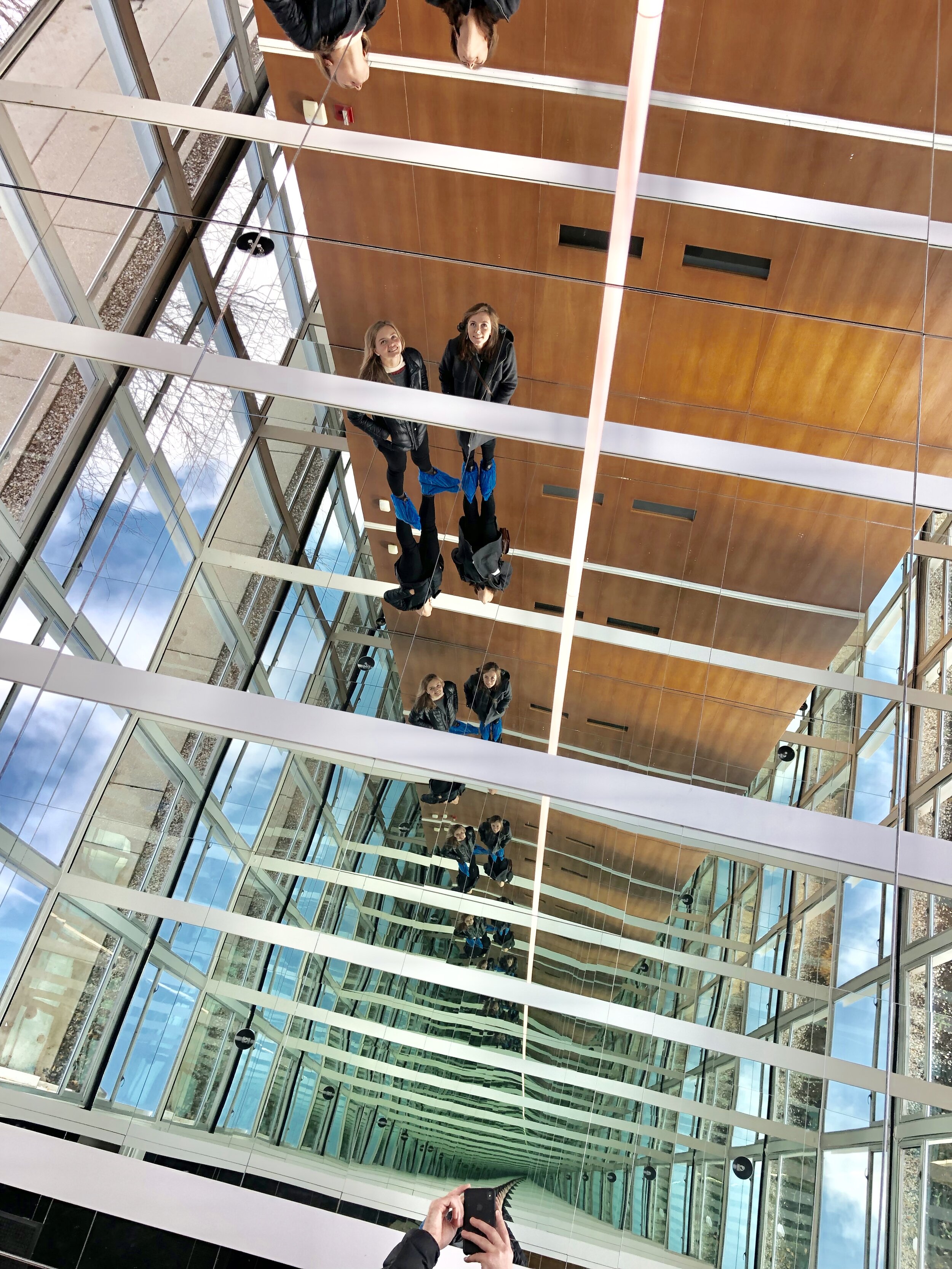Polarity Review
DAVID WALLACE HASKINS: POLARITY, September 2018 through January 2019
Review by: Bianca Bova
David Wallace Haskins traffics in the physical confrontation of abstraction. His light and space works are manifestations of apparitional architecture; drawing viewers into their seemingly limitless space only to emphasize the limits of perception. The efficiency with which the works on view in Polarity, his most recent solo exhibition at the Elmhurst Art Museum, accomplish this is owing in part to Haskins’ diligence as not just an artist, but as a consummate researcher, known for engaging professionals in the fields of psychology, ecology, physics, architecture and philosophy to help hone and inform his practice.
His Time Mirror III, one of the first works encountered in the exhibition, borrows from its earlier versions with the utilization of a digital mapping technique which allows several iterations of the self to exist simultaneously, on a minor time delay. To watch oneself follow oneself into a room is an evocative experience to say the least, allowing—however briefly—the exceedingly uncanny opportunity to view the self as a stranger. To linger in the space creates further psychological fissions, as mannerisms both deeply habitual and utterly foreign emerge. “There is a reverence to this work,” Haskins says, “a reverence that develops from conflating others with the self.”
Before one can reconcile themselves fully with the experience of Time Mirror III, they find themselves ushered into Architecture of Light. Perhaps the most elegant, and certainly the most deceptively simple work on view in Polarity, Architecture of Light draws the viewer into a room, a void, of what at first appears to be a space of monumental proportions. Cutting through the enveloping darkness is a series of incisive projections. They create pseudo-structures, conjure visions of water and sunlight, pull the body forward to bisect planes which do not exist in space, and reign in total silence, only to be revealed upon a last look to ultimately be a manifestation of the humble grid, building block of modernist architecture and Midwestern urban planning, and a sly nod to the Mies van der Rohe McCormick House on the museum’s campus, which part of the exhibition occupies. Uninterrupted by anything beyond the body in space, this installation brings about a complementary, if melancholy, kind of self-awareness to that created in the previous installation.
Ascension/Descension, which one reaches by crossing the courtyard (passing, along the way, Haskins’ signature Skycube, recently acquired for the museum’s permanent collection) and entering the McCormick House, may be described as an “infinity room.” It does conjure an unfathomable vastness from the application of mirrors to the entirety of the ceiling and floor of the historic home, but to dismiss it as a funhouse trifle is a mistake. The subtle, thoughtful manipulations of perception that take place therein owe their weight more to Mies than Kusama. The inexplicable stretching of space to make manifest the core conceptual experience of verticality in architecture--a sort of mirage skyscraper--wrought from a purely, starkly horizontal structure speaks not just to the arts-architectural heritage of the concepts of structure and of the city, but perversely forces one to work towards locating themselves in space. This in stark contrast to the preceding work; the viewer no longer an interruption of the plane, but rather a wraith-like element, existing everywhere and nowhere in shared fields of vision. The emotional component of this experience is equal to the perceptual one, both in the immediate feelings of disorientation created by movement through the space and the more latent reflections the domestic environment naturally gives way to.
A clear accomplishment on Haskins’ part, and proof positive that in the age of the “instagram museum” we cannot afford to dismiss contemporary light and space work. Where the former is often produced with documentation in mind, unconscious of the concerns of site specificity or responsiveness, the latter is profoundly tethered to its locale, and devoted to the physical and emotional response of first hand interaction. As Haskins notes, “Light and space work isn’t always possible to document in a meaningful way. In fact it insists on presence to have meaning. Its meaning is derived from visitation.”
That Haskins has chosen to maintain his practice in the Midwest bears consideration. The bulk of light and space work has, historically speaking, found its way to the West Coast. One of the most commonly cited reasons for this being the climate. With the harsh weather comes rather severe logistic limitations on outdoor installations, which become both time consuming and expensive to ameliorate. Nevertheless, a clarying call of Haskins’ is that, “something happens in a place when you stay in it.” There may be no better summation of the works on view in Polarity than that statement.










